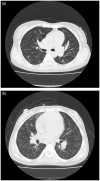Rare variants in RNF213, a susceptibility gene for moyamoya disease, are found in patients with pulmonary hypertension and aggravate hypoxia-induced pulmonary hypertension in mice
- PMID: 29718794
- PMCID: PMC5991195
- DOI: 10.1177/2045894018778155
Rare variants in RNF213, a susceptibility gene for moyamoya disease, are found in patients with pulmonary hypertension and aggravate hypoxia-induced pulmonary hypertension in mice
Abstract
Ring finger 213 ( RNF213) is a susceptibility gene for moyamoya disease (MMD), a progressive cerebrovascular disease. Recent studies suggest that RNF213 plays an important role not only in MMD, but also in extracranial vascular diseases, such as pulmonary hypertension (PH). In this study, we undertook genetic screening of RNF213 in patients with PH and performed functional analysis of an RNF213 variant using mouse models. Direct sequencing of the exons in the C-terminal region of RNF213, where MMD-associated mutations are highly clustered, and of the entire coding exons of BMPR2 and CAV1, the causative genes for PH, was performed in 27 Japanese patients with PH. Two MMD-associated rare variants (p.R4810K and p.A4399T) in RNF213 were identified in two patients, three BMPR2 mutations (p.Q92H, p.L198Rfs*4, and p.S930X) were found in three patients, whereas no CAV1 mutations were identified. To test the effect of the RNF213 variants on PH, vascular endothelial cell (EC)-specific Rnf213 mutant transgenic mice were exposed to hypoxia. Overexpression of the EC-specific Rnf213 mutant, but neither Rnf213 ablation nor EC-specific wild-type Rnf213 overexpression, aggravated the hypoxia-induced PH phenotype (high right ventricular pressure, right ventricular hypertrophy, and muscularization of pulmonary vessels). Under hypoxia, electron microscopy showed unique EC detachment in pulmonary vessels, and western blots demonstrated a significant reduction in caveolin-1 (encoded by CAV1), a key molecule involved in EC functions, in lungs of EC-specific Rnf213 mutant transgenic mice, suggestive of EC dysfunction. RNF213 appears to be a genetic risk factor for PH and could play a role in systemic vasculopathy.
Keywords: animal models; caveolin-1; endothelium; epigenetics; genetics; genomics.
Figures





References
-
- Kamada F, Aoki Y, Narisawa A, et al. A genome-wide association study identifies RNF213 as the first Moyamoya disease gene. J Hum Genet 2011; 56: 34–40. - PubMed
-
- Kudo T. Spontaneous occlusion of the circle of Willis. A disease apparently confined to Japanese. Neurology 1968; 18: 485–496. - PubMed
-
- Suzuki J, Takaku A. Cerebrovascular “moyamoya” disease. Disease showing abnormal net-like vessels in base of brain. Arch Neurol 1969; 20: 288–299. - PubMed
-
- Takeuchi K, Shimizu K. Hypoplasia of bilateral internal carotid arteries (in Japanese). Brain Nerve 1957; 9: 37–43.
LinkOut - more resources
Full Text Sources
Other Literature Sources
Molecular Biology Databases
Miscellaneous

